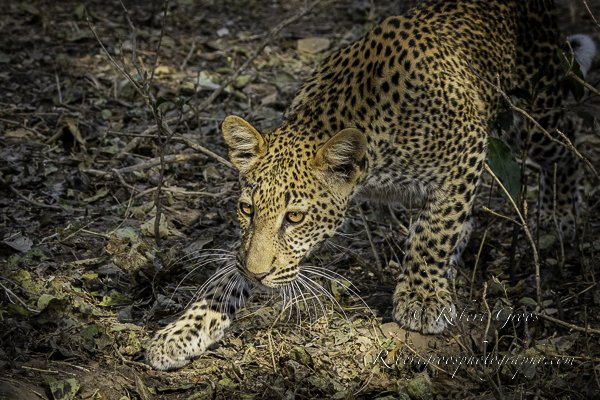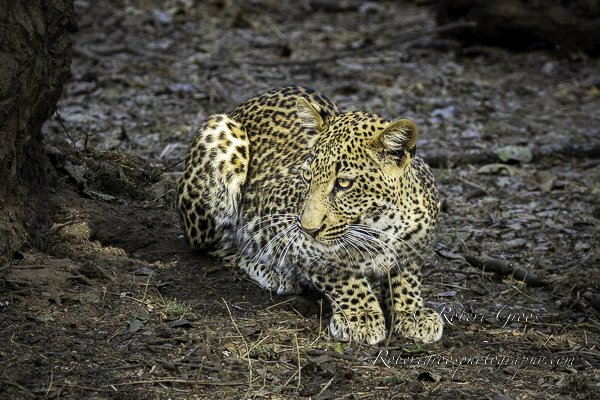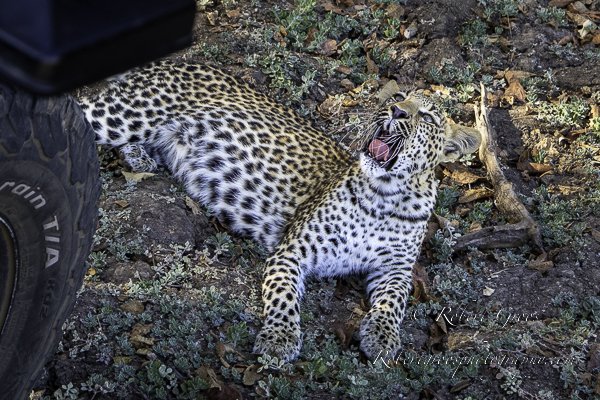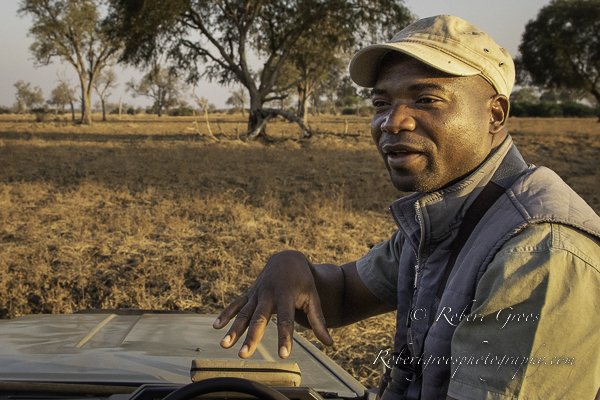Zambia Safari Part II: Leopard Sightings
Her name is Chipadzuwa. In the Nyanja dialect of Zambia, it means “beauty beyond that of the sun.” This is the name safari guides in the South Luangwa National Park gave this female leopard whose territory is in the vicinity of the camp my wife and I visited while on safari. This is her story.
Our guide, Mukupa, spotted Chipadzuwa in the near distance. She blended in with the landscape so well that I had to ask “where” more than once. The sighting occurred at the start of our very first game drive. I had read a travel article that stated “if you don’t see a leopard in Zambia, you need to buy new glasses.” Chipadzuwa was, indeed, a beautiful sight, and our safari was off to a good start.
Just the morning before, we were told, Chipadzuwa had brought down an impala, only to have that prize stolen from her by two other predators: a lion and a hyena. On this day, she was again on the hunt. Because foliage and terrain prevented us from getting close, we set about looking for her two, eight month-old cubs.
If you have cats, you already know what leopard cubs do while mom is off at work: they sleep a lot. Otherwise, they lie around looking quite bored while waiting for something to grab their attention. If they hear or see movement in the leaves on the ground, they will instantly perk up, and perhaps pounce, just like your own kitty if you present a mouse toy or laser light. At this age, they may hunt for small animals like squirrels or frogs.
With their superior strength and agility, leopard cubs can do much more than our house cats, we discovered. They might play tag in low hanging branches, or chase each other up into the trees. In that instance, there will be no need to call the fire department for a ladder to coax them to the ground. They are adapted to climb up and down tree trunks easily, and with lightning speed. Attacking prey from the tree branches above is a stealth skill they must learn in order to survive. But these two cubs were too young for that.
Leopard cub on tree branch.
Chipadzuwa, meanwhile, was successful in bringing down another impala while we were observing her cubs about a mile away. We came upon her as she was struggling to drag the still breathing quarry into the shadows of thick brush where, hopefully, she could hide it from other predators. Had the impala been smaller, she might have hauled her prize up onto an overhanging tree branch for safekeeping, but not this morning.
We continued onward with our morning game drive, observing elephants, zebras, lions, hippos, crocodiles, and birds. That evening, upon returning to the kill site, we found that fortune had turned against Chipadzuwa. There was not much left of the carcass (who consumed it, we don’t know for sure), and she was fiercely engaged in a tug-of-war with a lone hyena for the remaining spoils of her hunt. The following video is a recap of that encounter.
A leopard and a hyena fight over impala carcass.
At least three days had gone by without being fed by mom when we next found the leopard cubs. We parked nearby to observe their behavior. They were sleeping together on the ground in an open, shaded area. The sound of the jeep motor awoke the two of them.
Our safari jeep became something the two cubs decided to investigate at close range. At first, they just wandered around the periphery. Seeing no apparent danger, they then approached the vehicle with clear intent of walking underneath as if it was part of the natural landscape (and, maybe it is, as tourists in safari jeeps are present most every day).
One of the cubs parked himself alongside the right front fender, about eight feet from my vantage point. It mouthed a big yawn. Those big paws, hairy ears, bristling whiskers, were something I had to capture, so I decided to record its behavior.
Not having room for a tripod, I rested my arm on a side railing and handheld my camera over the edge. At first indifferent to my gaze, the cub eventually sat up and looked intently at my camera (or was it my hand?). At that moment, Mukupa said: “time to stop,” and I quickly complied, even though I was eight feet away inside a jeep. The leopard cub’s demeanor had changed from total disinterest to, well, just click below:
A leopard cub taking an interest in my hand holding a camera.
We weren’t in any danger. Apex predators like lions and leopards do not perceive humans inside safari jeeps as prey. They may walk right alongside a jeep without incident (perhaps to give tourists a thrill?). An adult lion did just that one morning along the side of the jeep where my wife was seated. So close that she might have reached out and touched it, but she kept her hands in her lap. It never hurts to be cautious.
We do know from observations the following day that Chipadzuwa, once again, had still not been able to provide her cubs a fresh meal. She did, however, bring them something: the decaying remains of a stork. What nutrition remained in this castoff, I cannot say. One of the cubs, however, found the stork of sufficient interest to occupy itself for several minutes. For all its efforts, it came away with a mouth full of feathers.
A leopard cub tries to eat stork feathers.
A leopard crouches between tree branches above its intended prey.
Our last game drive provided several minutes of suspense. Far from our camp, we spotted another leopard crouched in the branches of a Sausage-tree (Kigali africana), a tree whose pendulous gourds, leaves, and flowers provide nutrition for several browsing species in Africa. Below the leopard stood a male Puku, grazing upon the deep red flowers that had fallen to the ground. Antelope love eating those flowers, and gather regularly to consume them. On my own property in rural, central California, deer regularly consume the Mimosa flowers that fall to the ground in late summer. I never have to sweep them up.
This leopard gazed intently upon the Puku, with muscles tensed, just waiting for the right moment to descend in a lightning flash. It might appear to be an easy kill opportunity, but the Puku’s horns could easily impale a careless leopard.
We watched in suspense, anticipating a dramatic denouement to the drama playing out before us. But baboons spoiled the show. Having caught sight of the leopard, they began barking up a storm. Her menacing presence was thus announced to all in peril, and another opportunity for a kill was lost. In spite of what we might think, odds do not always favor the predator.
One of my greatest “wish for” events in going on safari in Zambia was to see a leopard. Not just any leopard, though. Ideally, it would be one of those iconic scenes: a leopard lounging on a tree branch, with a fresh kill in its paws; and, yes, I would have a view of that leopard unobstructed by tree branches, so I might take home a trophy photograph. I was well aware that this scenario was a tall order, but I was hopeful. On balance, I’d say I was served up at least the equivalent of my order, if not more, thanks to our guide, Mukupa, of Lion Camp, in South Luangwa National Park.
Two leopard cubs sleeping in the open shade
This post is the second in a series of three about my safari in Zambia, you can find the first story, Big Cats, here. Any questions? Just let me know.
If you enjoyed this post, please share the link with your friends. To be added to my mailing list for future articles, contact me at: robertgroos1@gmail.com. Your information will not be shared, and you can unsubscribe at anytime. Thank you.











